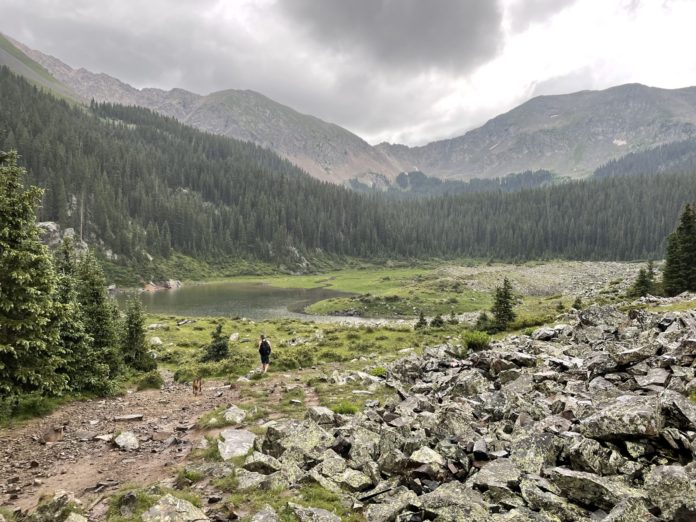Editor’s note: This is San Antonio Report Editor Robert Rivard’s final summer travelogue. His regular column resumes Sunday.
Rainfall in Taos and northern New Mexico, locals say, is the best in at least five years. Afternoon thunderstorms, some intense and prolonged, were a daily experience during our week of fly fishing, river rafting, hiking, and cultural exploration.
Yet even on the clearest of days, the curtain of haze that enveloped the Sangre de Cristo mountains was evidence that Oregon’s catastrophic Bootleg Fire reached far beyond the state’s borders. Smoke and contaminants from wildfires in Canada and the West Coast now reach the entire country, as seen in this New York Times map.
We experienced more than itchy eyes and throats in New Mexico this past week. Even with the rains, temperatures soared an average of 10 degrees above normal, hitting 90 degrees many days. My son Nicolas and I were fly fishing the Cimarron River on one such day when our guide noted that water temperatures had risen to 72 degrees by mid-afternoon, putting the trout at risk if stressed. We packed up and returned to our lodging.
The following day my wife Monika, Nicolas, and I set out on the 4.2-mile, out and back Williams Lake Trail in the Taos Ski Valley in the Carson National Forest. The moderate to intermediate hike was meant, in part, to test my progress 48 days after knee replacement surgery. The trail starts at 10,200 feet and ends at 11,100 feet. I gained a full appreciation on the way up of the thinner air at that altitude. We didn’t get started until midday, and many hikers passed us on their way down. At the top, we were alone at the lake when a sudden storm enveloped us with crashing thunder and lightning, and a downpour that quickly turned into a hailstorm. Small pebbles grew to marbles and then larger as we took shelter. Temperatures plunged into the low 40s. As the hailstorm finally began to diminish, we followed our rescue dog, Cacteye, down the mountain in double time, soaked to the bone, making our way through inches of accumulated hail.
Such mountain storms are not uncommon, of course, and can’t necessarily be attributed to climate change, but severe weather and unexpected weather events are becoming increasingly common, seemingly everywhere, including the unusual “cold front” that came through San Antonio in our absence.
As the San Antonio Report’s Jackie Wang reported Friday, Mayor Ron Nirenberg appointed a new City Council committee, the Municipal Utilities Committee, that will “oversee the implementation of programs and policies at San Antonio Water System and CPS Energy, including the recommendations from the Emergency Preparedness Committee.”
The committee on emergency preparedness, which Nirenberg formed soon after the February freeze, spent four months investigating the city’s winter storm response. The seven-person committee ultimately deemed the Texas power market’s regulatory structure as the main cause of the crisis but also included recommendations for SAWS and CPS Energy to avoid future crises in its final report.
News of the new City Council committee came two days after it was announced that longtime CPS Energy Board Trustee and former chairman Ed Kelley will step down at the end of his term at year’s end. Lindsey Carnett reported that the search for Kelley’s replacement, drawn from the utility’s Quadrant 1, or northwest part of Bexar County, will begin immediately.
Four trustees each represent a quadrant; the fifth trustee is Nirenberg, who serves in his capacity as mayor. The trustees self-select their successors, who are then approved by City Council.
Kelley’s successor will face a challenging assignment: how to help navigate CPS Energy toward a more sustainable future even as it works to maintain affordable rates and reliable service. Those levels of service were put to the test with the severe winter storm in February. The utility’s board and leadership are now struggling with $1 billion in unbudgeted energy costs.
Kelley, whose final term will end on Jan. 31, 2022, is one of the most visible and respected business leaders in the city. Over the years, he has served on or chaired a long list of chamber, community, and nonprofit boards. I am a longtime admirer of Kelley, although we disagree on a range of political and environmental issues. I’ll expand on that in my Sunday column, and why it’s important for community leaders and the media to look beyond the bitter political divisions in Texas and the nation to find common ground in moving San Antonio forward.
Credit: Source link































